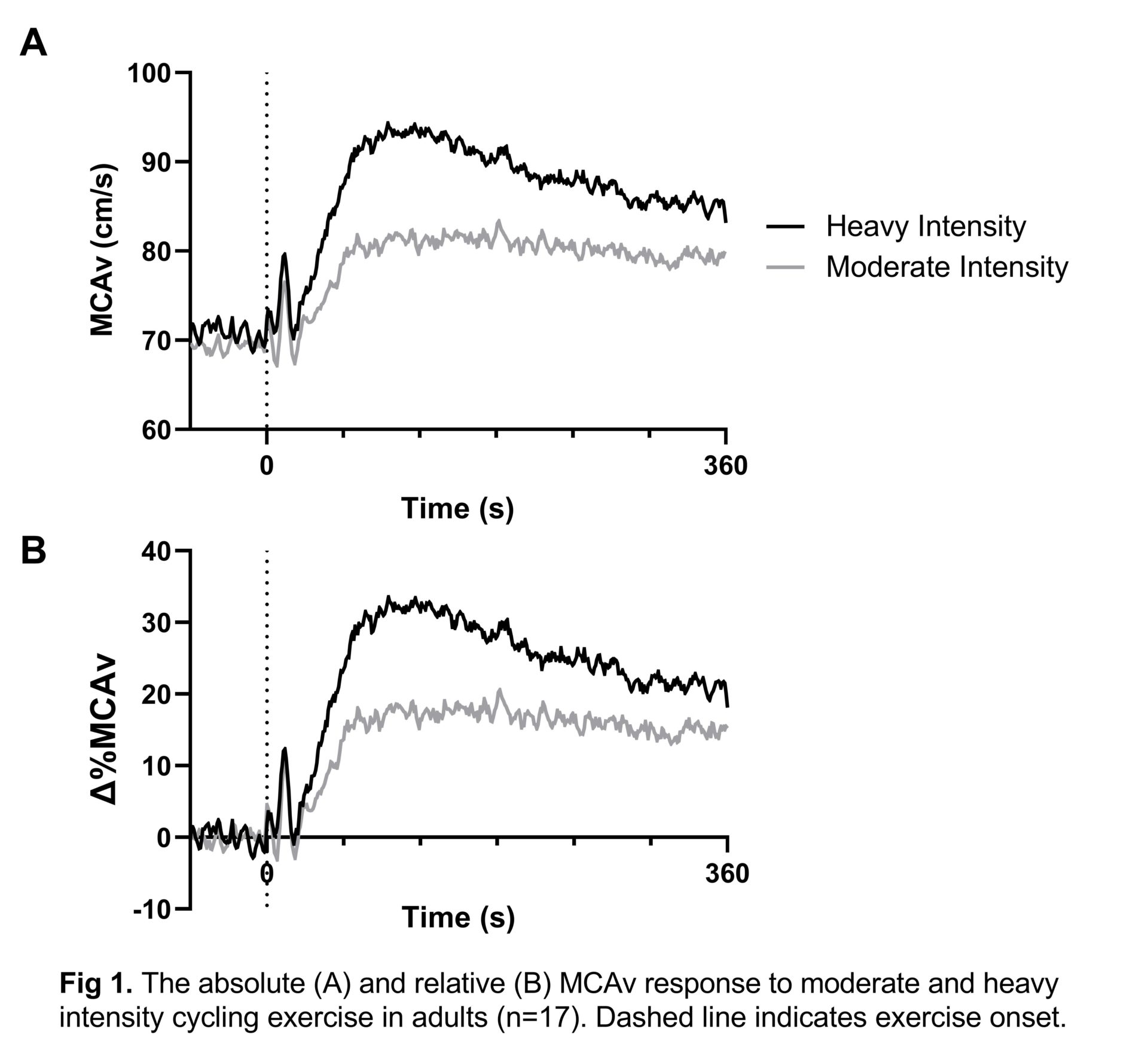The kinetic response of the middle cerebral artery blood velocity (MCAv) response to steady-state moderate-intensity exercise on a recumbent stepper has been modelled previously in healthy adults, using a mono-exponential function with a time delay. However, no data exist regarding the MCAv kinetic response to whole body upright cycling, nor heavy-intensity exercise, which may require a more complex approach due to hyperventilation-induced hypocapnia. Data from incremental exercise suggest that moderate-intensity exercise elicits the greatest increases in MCAv, though this has yet to be explored during constant work rate exercise. The aim of this study was to compare the amplitude and time-based parameters of the MCAv response to moderate and heavy-intensity cycling in adults using an exponential model. Seventeen healthy adults (23.8±2.4 years, 8 males) completed a ramp incremental test to exhaustion on a cycle ergometer to determine maximal oxygen uptake and the gas exchange threshold (GET). Participants then completed three 6-minute transitions at a moderate-intensity (90% GET) and three 6-minute transitions at a heavy-intensity (40%Δ) in a counterbalanced order, all on separate visits. Bilateral MCAv was measured throughout using transcranial Doppler ultrasonography. MCAv mean data were exported as 1-sec averages and time aligned to exercise onset. For each participant, left and right MCAv data from each corresponding repeat transition were obtained and pooled, resulting in six sets of MCAv data per person that were subsequently averaged. The MCAv response to each intensity were analysed using a mono-exponential model with a time delay for each participant. Differences in kinetic parameters between moderate and heavy-intensity exercise were explored using paired t-tests. Baseline MCAv before each trial was similar between intensities (69.4±9.1 vs. 70.8±8.4 cm.s-1, P=0.16). At exercise onset, consistent, rapid fluctuations in MCAv were observed within both intensities for ~25 s, before MCAv increased in an exponential-like fashion. The time constant of the MCAv kinetic response was similar between moderate- and heavy-intensity cycling (25.4±9.7 vs. 26.0±7.7 s, P=0.82), as was the time delay (29.3±11.3 vs. 29.1±9.6 s, P=0.95). The amplitude of the MCAv increase from baseline was significantly greater during heavy (23.9±10.0 cm.s-1, 34.1±14.4%) compared to moderate (12.7±4.4 cm.s-1, 18.7±7.5%) intensity cycling (both P<0.01). After attaining a peak or steady state, MCAv decreased as the exercise bouts progressed within each intensity. This occurred significantly earlier during heavy intensity exercise (164±43 vs. 248±90 s, P<0.01), and MCAv decreased by a significantly greater magnitude during heavy intensity exercise, compared to moderate (9.5±6.9 vs 2.8±3.8 cm.s-1, P<0.01). Nevertheless, MCAv at the end of the bout remained elevated during heavy intensity exercise, compared to moderate (85.2±9.6 vs. 79.3±7.7cm.s-1, 21.1±12.7% vs. 14.9±7.8%, P≤0.01). These novel findings indicate that the MCAv kinetic response to moderate and heavy intensity cycling in adults can be modelled using an exponential function, and revealed that increases in MCAv are greater during constant work-rate heavy intensity cycling, compared to moderate, but that the time constant and time delay of the responses are similar between intensities. These novel analysis techniques form an important area to explore cerebrovascular responses and regulation during exercise.
Future Physiology 2021 (Virutal) (2021) Proc Physiol Soc 47, PC17
Poster Communications: The Middle Cerebral Artery Blood Velocity Response to Moderate and Heavy Intensity Cycling In Healthy Adults
Max Weston1, 2, Alan Barker1, Owen Tomlinson1, Jeff Coombes2, Tom G Bailey2, Bert Bond1
1 Children's Health and Exercise Research Centre, Sport and Health Sciences, College of Life and Environmental Sciences, University of Exeter,, Exeter, United Kingdom 2 Physiology and Ultrasound Laboratory in Science and Exercise, Centre for Research on Exercise, Physical Activity and Health; School of Human Movement and Nutrition Sciences, The University of Queensland, Brisbane, Australia
View other abstracts by:
Where applicable, experiments conform with Society ethical requirements.

